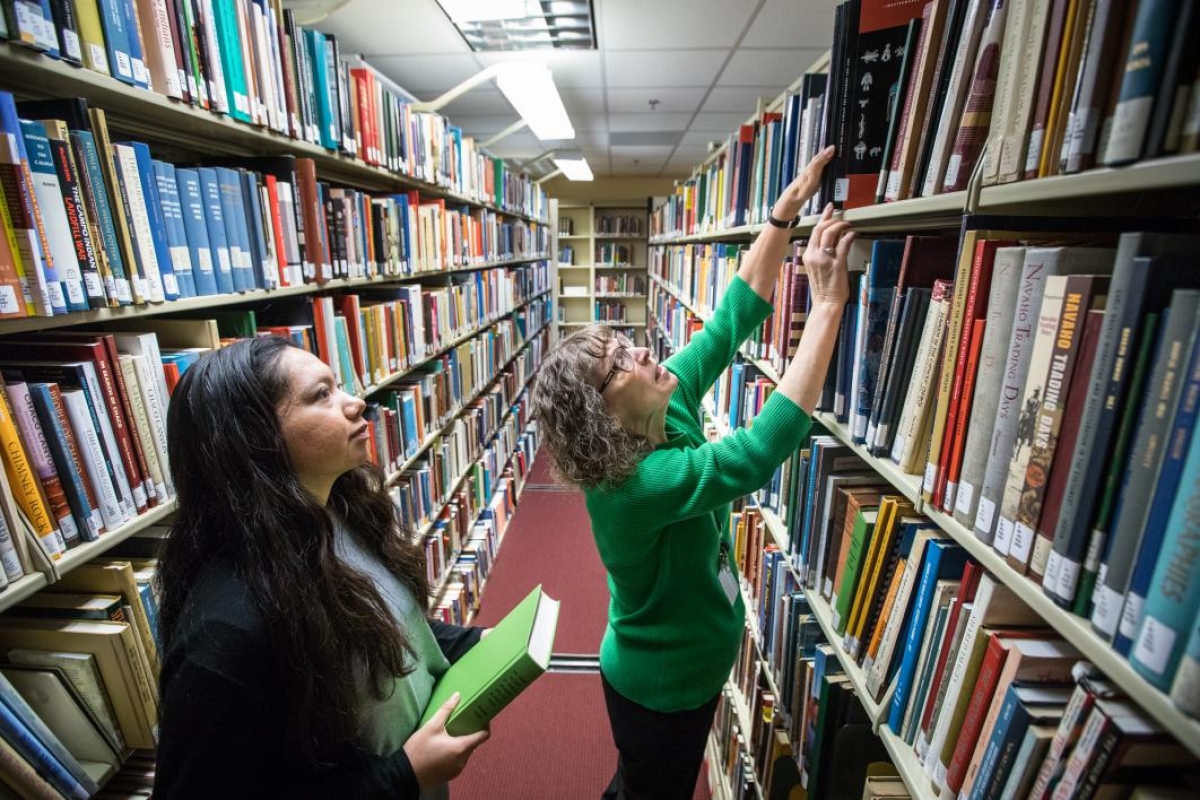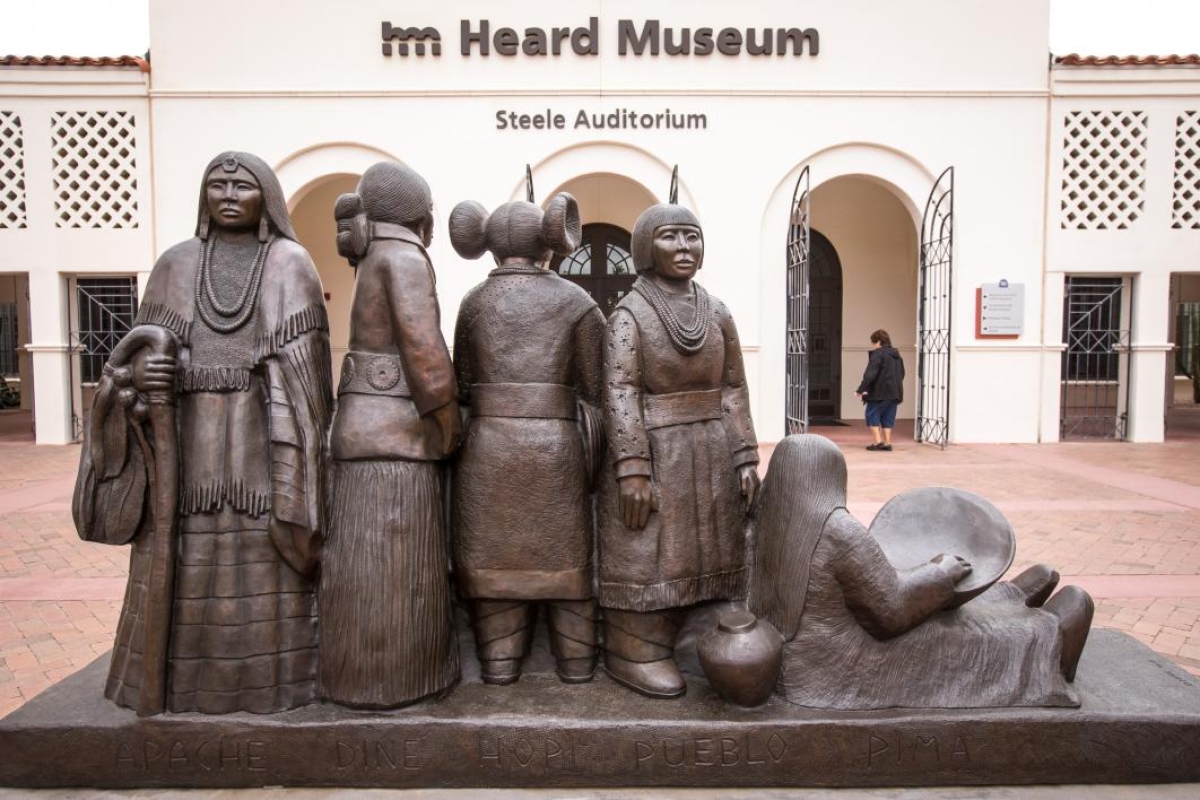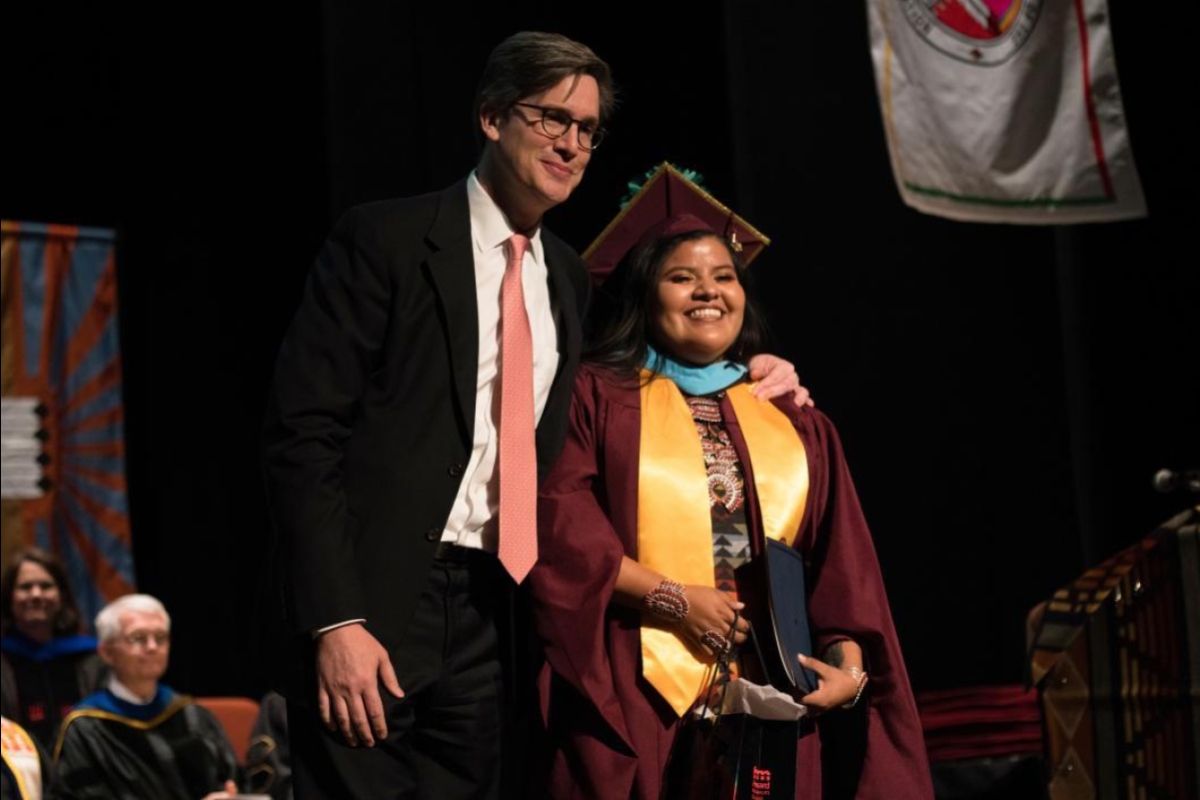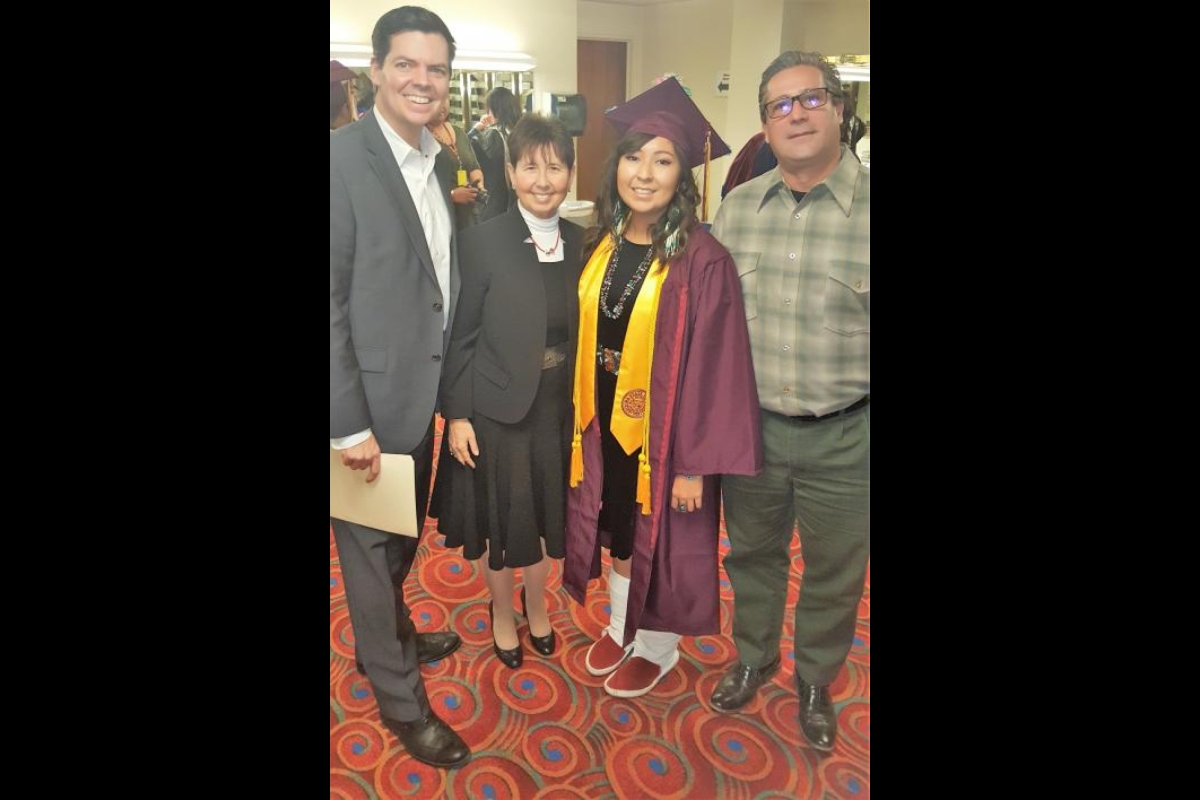ASU interns bring imagination, creativity, cultural knowledge to Heard Museum collaboration
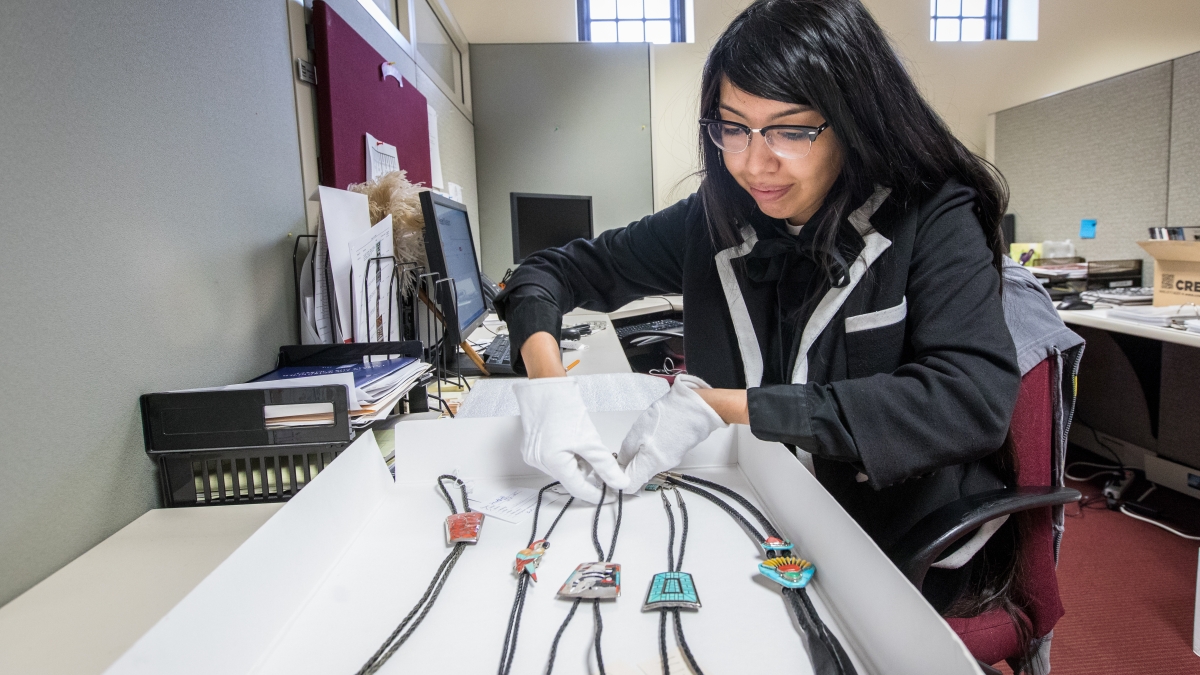
“I’m kind of on a roll with cataloging,” noted ASU alumna and Mellon Fellow Kayannon George, as she neared completion of cataloging the Norman L. Sandfield collection of bolo ties. Photo by Charlie Leight/ASU Now
The recent launch of the partnership between Arizona State University's Herberger Institute and the Los Angeles County Museum of Art — to support the training of a new diverse generation of museum professionals — made national headlines. For the last three years, a hometown collaboration between ASU’s American Indian Student Support Services and Phoenix’s Heard Museum has been contributing to a similar goal.
The Heard Museum Guild Internship Program, first piloted in spring semester of 2015, offers ASU American Indian students the opportunity to contribute to, and gain a firsthand understanding of, the many moving parts involved in sustaining this internationally renowned institution.
“ASU interns are an integral part of the imagination and creativity we hold dear here,” said Marcus Monenerkit, Heard Museum director of community engagement. A 2011 graduate of ASU’s Master of Nonprofit Studies program, Monenerkit has frequently collaborated with ASU faculty, staff and students in his 20-year career with the Heard Museum. But it’s clear that over the last three years, bringing guild interns into every dimension of the work in his area has become organic.
“They get to know our 11 galleries and we look for their input on new projects from the conceptualization phase forward.” Monenerkit explained. “We’ll go to other museums to see new ways of handling the spaces. They’ll work with artists who exhibit and conduct demonstrations and workshops here. They also get involved as we collaborate with other museums and private collectors to put together innovative exhibitions that connect art across time and cultures.”
Heard Museum membership coordinator Christina Harris, who comes from a family of artists from Zuni Pueblo, the Hopi Tribe and the Tohono O’odham Nation, said of the internship program that continuing to bring additional Native voices into the work of the museum “will make the institution even more knowledgeable and the art world, in general, more sensitive to art connected with deep meaning and ceremonial and religious significance."
“The Heard is a partner in bringing voice to that as well as to a greater understanding that, while some things in Native communities are being done the same way they have been since time immemorial, these are living, breathing communities where artists are also on the cutting edge, making art that is powerful politically, environmentally, socially,” said Harris, an alumna of ASU’s American Indian studies bachelor’s degree program. “I love that the Heard not only reflects the past but is contemporary.”
“Over the last three years we’ve seen the internship program grow in terms of the number of departments sponsoring interns and in strengthening the depth of the experience for students,” said American Indian Student Support Services Associate Director Laura Gonzales-Macias, who was part of the original team to lay the groundwork for the partnership. “Our Heard partners very much have the same ideas we at ASU do about wanting students to be able to apply and develop career-related skills and grow their professional network.”
The internships, which carry a stipend and the potential for academic credit, are funded by the work of the Heard Museum Guild, the museum’s cohort of committed community volunteers.
“Matching students with placements also involves the American Indian Student Support Services coordinators at each ASU campus, who help in pre-screening candidates,” Gonzales-Macias said.
To date, 25 intern positions have been filled with 18 (seven returning) ASU students in the program, assisting in areas from curation, education and community engagement to fundraising, development and finance.
Recently, several Heard Museum Guild interns — past and present — and their supervisors sat down with ASU Now to talk about the internships and their reverberations.
Transitioning from archaeology to fine art
Art conservation wasn’t on Kayannon George’s career radar when the Deer Valley High School graduate transferred to ASU from Glendale Community College to major in anthropology. Even when she applied to the Heard Museum Guild Internship her junior year it was motivated by her strong interests in archaeology.
“But it soon became about the fine art,” said George, who is of the White Mountain Apache and Navajo tribes and graduated from ASU in December 2016. “As a Heard Museum Guild intern I was introduced to aspects of museum work that I’d never really heard about before. I’ve become really interested in hands-on work with the art and the conservation and maintenance of textiles and ceramics.”
Her internship experience also opened up opportunities to pursue her passion for this specialty area of museum work.
Last July when the Heard Museum was awarded a six-figure grant from the Andrew W. Mellon Foundation for fellowships to support the training of the next generation of museum conservators, particularly within the Native American community, George’s former colleagues at the Heard asked her if she’d consider applying.
From more than 40 applicants, she was selected as one of the first three Mellon Fellows and completed the nine-month appointment at the beginning of June.
“I’d like to stick around and work with the Heard collections,” said George about her future plans, “while also keeping my eyes open for interesting residencies or applied workshops in museums around the country. I’m applying for an internship at the National Museum of the American Indian, part of the Smithsonian Institution, this next year. Eventually I’ll attend graduate school in museum studies.”
Building an unparalleled archive
In spring 2018, sophomore Modesta Molina became the second intern to assist in the Heard Museum’s Billie Jane Baguley Library and Archives. At ASU she’s majoring in interdisciplinary studies in the College of Integrative Sciences and Arts, completing concentrations in sustainability and justice studies, and minoring in American Indian studies.
Molina, a member of the Pasqua Yaqui Tribe, had worked last summer in the Maricopa County Library District branch library in the town of Guadalupe. So when she saw that the Heard Museum Guild Internship form included the library as a placement option, she thought it would be a good fit with her experience and her interest in going on to law school.
The library maintains extensive holdings about indigenous art and cultures from around the world and an unparalleled resource collection: physical files and an electronic database of information about nearly 25,000 American Indian artists collected over the last 40 years.
“The Heard Museum Guild Internship has been great!” observed Molina, who began her internship in February. “My favorite part of the internship has to be experiencing all of the events that go on at the Heard. I have also learned so much about the importance the library plays here at the Heard and with the community. It provides a reference for museum staff and knowledge for scholars. I enjoy contributing my part to keeping the library going.”
Growing a continuous revenue stream
Michael Avila, a senior majoring in global management at ASU’s West campus, jumped in and started his internship on one of the busiest weekends of the year for the museum, during the 28th annual World Championship Hoop Dance Contest in February. The 2018 event drew about 5,000 guests and 1.7 million viewers streamed the event live around the world including from Sweden, Australia, New Zealand, Belize and Canada.
“I greeted guests and talked with them about potentially considering a Heard membership,” said Avila, whose spring 2018 internship was focused on business development. A graduate of Sunnyslope High School, he earned an associate degree in business at Phoenix College before transferring to ASU.
“Growing a continuous revenue stream depends on memberships and sponsorships, and we track about 6,300 households and contributions across three giving programs,” noted Rebecca Simpson, Heard Museum associate director of development. “So we have been seeking Michael’s help in the messaging we create to ‘sell’ our programs to those audiences as we carry out our educational mission. We’re like our own little small business with a heavy focus on marketing, data management and analytics, and event management.”
That dynamic was partly what drew Avila to apply to the program.
“I applied for the Heard Guild Internship because I have an interest in entrepreneurship and small business management (my dad owns his own construction company) and also to explore the business side of managing a nonprofit,” Avila observed. “I also saw it as a chance to connect with my heritage.”
Enjoying ‘a crash course in professionalization’
Helping to plan and host the 2018 World Championship Hoop Dance Contest bookended Diamond Rivera’s two semesters of internship working with Shaliyah Ben, the Heard Museum director of public programs.
Rivera, who is from the Fort Yuma Quechan Indian Tribe and graduated from Gila Ridge High School in Yuma, said she had heard of the museum before attending ASU, but her first experience with the Heard Museum was just before applying for the internship.
“I went up and enjoyed exploring the museum on my own,” she said, noting that the museum admission is always free to Native Americans.
“The department I was in really gives you a crash course in professionalization in the workplace,” said Rivera, who will graduate from ASU in December with a major in exercise and wellness.
“You learn to talk with a wide variety of people and I got involved in budgeting, planning and executing events,” she noted. “Into some of the programming, such as First Friday events, I was able to design elements related to making a healthy lifestyle and came up with activities that would be age-appropriate for youth and family-friendly — all directly tied into my career path.
“It was also just really fun to be a part of the staff,” she said, “participating in movie nights or enjoying doughnuts together!”
Doing work that encompasses every passion
Martisha “Tisha” Clyde, who held a Heard Museum Guild internship in fall 2017, said her decision to accept a staff position with the Heard Museum shortly after graduating was an easy one.
“It encompasses all I was looking for: a focus on the art world, Native American artists and tribal communities, and making connections with people,” observed Clyde, who majored in design studies at ASU. “The atmosphere while I was an intern was always energetic, and rather than feeling like I was going to work, I felt like I was going to be with my family every day.”
In her position with the curation and education staff, she’s supporting the museum’s fundraising work, doing research for donor cultivation, and helping coordinate messaging across all of the Heard membership groups and with nonmembers.
As an intern, Clyde got very involved in planning events from the ground up, and her innovations led to some impressive results.
“Tisha took on a lot of details involved in coordinating the annual Moondance Gala, held in conjunction with a significant exhibition opening each fall,” explained Dan Hagerty, the museum’s director of strategic development and programming. “With the Silent Auction, she helped build out an online component that allowed participants to bid on items before the day of the gala. The auction raised $60,000 more than ever before.”
Telling human stories
Samantha Toledo has also grown her Heard Museum involvement beyond the boundaries of the guild internship. Toledo first began working in the education side of the Heard Museum as an intern with Monenerkit in spring 2017 while completing her undergraduate degree in English and secondary education. A May 2018 graduate of ASU’s master’s program in educational policy, she continues to contribute to the museum as an education specialist.
“I love that at the Heard Museum we’re basically dealing with human stories,” Toledo said, “and I appreciate that I can be creative and practice intuition in doing exhibit prep work and in designing mock-ups and materials for our public programs and presentations, such as exhibition lectures, educational and outreach initiatives with artist communities, hands-on activities for families and school tours, as well as public events.”
Toledo has participated, for example, in artists’ pottery workshops in San Diego and along the Colorado River in Parker, Arizona, and a weaving workshop in Window Rock, on the Navajo Reservation, which was quite a special experience.
“My grandmas have passed away, but it was like I was learning from my grandmothers to weave the proper way,” she said.
“The Indian art community is kind of small,” Monenerkit observed. “So including interns in significant opportunities to work with artists and museum professionals regionally and nationally, they really begin to build their networks.”
“Being with the artists and their art brings new measures of resiliency and flexibility of thought, especially for Native communities and students,” Toledo added. “The art and stories turn on a light for you in facing new challenges our societies have never come across before.
“Someday I may go back home to the Navajo reservation to teach,” she continued. “I didn’t have a Navajo English teacher when I was in high school. I’d like to be a role model as kids are at a point where they’re thinking about their future.”
Broadening the partnership
At ASU’s American Indian Convocation on May 9, Toledo and doctoral graduate Jameson “JD” Lopez were recognized with Heard Museum Eagle Spirit Awards, which the museum has sponsored at this special interest convocation since 2013.
The awards, for which students apply for consideration, honor one master’s candidate and one doctoral candidate for academic achievement and service to community. They are emblematic of how the strong sense of connection and partnership between ASU’s American Indian Student Support ServicesASU American Indian Student Support Services is a unit of ASU's University College. and the Heard Museum continues to lead to other opportunities for mutual support.
“Sometimes the museum will contact us to see if students have interest in volunteer roles for special events,” Gonzales-Macias said, “which students often appreciate to meet community service requirements for scholarships, or to broaden their resumes.”
Spending time at the Heard Museum is now an activity that American Indian Student Support Services regularly builds into its student programming, including its SPIRIT early-start program for indigenous freshman students. This year the Heard Museum sponsored the SPIRIT reunion for the 2017 freshman cohort.
“Experiencing the museum’s broad emphasis on intertribal connections and on knowledge, art and lived culture of the 22 federally recognized tribes with lands in Arizona, can be very orienting,” Gonzales-Macias added.
Gonzales-Macias often shares with new ASU students the impact of her first visit to the Heard Museum when she moved to Arizona in 1993 as a first-year ASU graduate student.
“I was new to Arizona from Texas and wasn’t yet feeling connected here. My husband (then-fiancé) and I went up to the Heard’s annual American Indian Fair and Market, wanting to get a stronger sense of this place where we were living,” she said. “I came away feeling more grounded and had an especially nice conversation with an artist from the Winnebago tribe in Wisconsin. I purchased from her a beaded necklace and earrings to mail home to my mother. My mother has since passed, but I now have the jewelry, as well as the postcard I sent her describing our visit to the museum. It reminds me of a treasured time and a milestone in my experience.”
More Arts, humanities and education

ASU center to host Spike Lee for 2025 'Delivering Democracy' dialogue
The Center for the Study of Race and Democracy (CSRD) at Arizona State University will host Academy Award-winning filmmaker and…
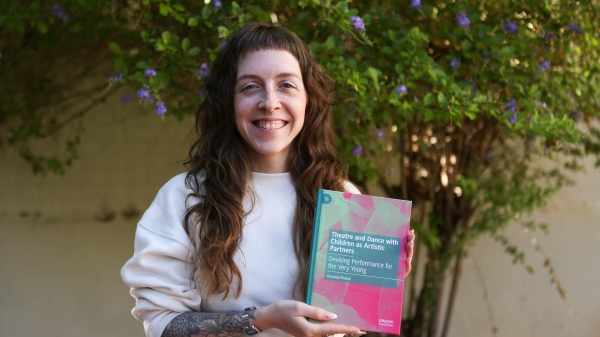
ASU professor explores theater, dance for young children in new book
Arizona State University Assistant Professor Amanda Pintore believes in the artistic capacity of very young children. She's…
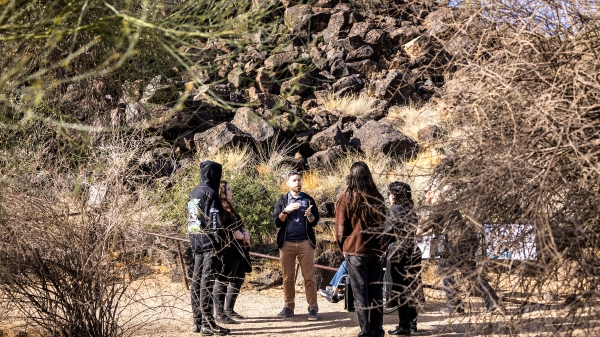
Petroglyph preserve celebrates 30th anniversary with ancient, modern tales
The Deer Valley Petroglyph Preserve provides a beautiful walk through a pristine desert where chuckwalla lizards are as plentiful…
